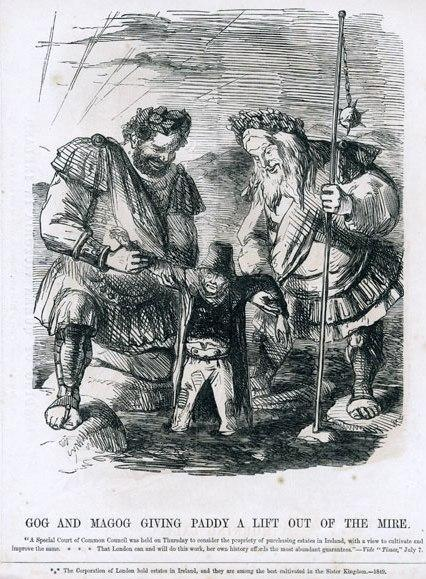Funnily enough Gog and Magog are also a part of British myth. These are the names of two Giants from the legends of ancient Britain. They were children from the evil daughters of Diocletian who ruled the British Isles. A Trojan called Brutus came to the land to conquer it. He fought Gog and Magog and had them chained to the gates in London. Some believe that Gog and Magog were the last of the Giants that ruled Britain and that they were imprisoned by Alexander the Great behind bronze and iron gates. When King Arthur came to Britain the two Giants escaped and fought in the court of the King. A French tale states that Gos et Magos as they are known, were killed by the Giant Gargantua. Effigies were made to guard the London Guildhall. The originals were destroyed in the Great Fire of London. New ones were made but these were lost in the bombings of the Second World War. Now a third set of statues have been cast and still stand. Gog holds a mace while Magog is armed with a spear.
Also of note:
Despite their generally negative depiction in the Bible, Lord Mayors of the City of London carry images of Gog and Magog (depicted as giants) in a traditional procession in the Lord Mayor's Show. According to the tradition, the giants Gog and Magog are guardians of the City of London, and images of them have been carried in the Lord Mayor's Show since the days of King Henry V. The Lord Mayor's procession takes place each year on the second Saturday of November.
The Lord Mayor's account of Gog and Magog says that the Roman Emperor Diocletian had thirty-three wicked daughters. He found thirty-three husbands for them to curb their wicked ways; they chafed at this, and under the leadership of the eldest sister, Alba, they murdered their husbands. For this crime they were set adrift at sea; they washed ashore on a windswept island, which they named "Albion"—after Alba. Here they coupled with demons and gave birth to a race of giants, whose descendants included Gog and Magog.[54]
An even older British connection to Gog and Magog appears in Geoffrey of Monmouth's influential 12th-century Historia Regum Britanniae, which states that Goemagot was a giant slain by the eponymous Cornish hero Corin or Corineus. The tale figures in the body of unlikely lore that has Britain settled by the Trojan soldier Brutus and other fleeing heroes from the Trojan War. Corineus supposedly slew the giant by throwing him into the sea near Plymouth; Richard Carew notes the presence of chalk figures carved on Plymouth Hoe in his time. Wace (Roman de Brut), Layamon (Layamon's Brut) (who calls the giant Goemagog), and other chroniclers retell the story, which was picked up by later poets and romanciers. John Milton's History of Britain gives this version:
The Island, not yet Britain, but Albion, was in a manner desert and inhospitable, kept only by a remnant of Giants, whose excessive Force and Tyrannie had consumed the rest. Them Brutus destroies, and to his people divides the land, which, with some reference to his own name, he thenceforth calls Britain. To Corineus, Cornwall, as now we call it, fell by lot; the rather by him lik't, for that the hugest Giants in Rocks and Caves were said to lurk still there; which kind of Monsters to deal with was his old exercise.And heer, with leave bespok'n to recite a grand fable, though dignify'd by our best Poets: While Brutus, on a certain Festival day, solemnly kept on that shore where he first landed (Totnes), was with the People in great jollity and mirth, a crew of these savages, breaking in upon them, began on the sudden another sort of Game than at such a meeting was expected. But at length by many hands overcome, Goemagog, the hugest, in hight twelve cubits, is reserved alive; that with him Corineus, who desired nothing more, might try his strength, whom in a Wrestle the Giant catching aloft, with a terrible hugg broke three of his Ribs: Nevertheless Corineus, enraged, heaving him up by main force, and on his shoulders bearing him to the next high rock, threw him hedlong all shatter'd into the sea, and left his name on the cliff, called ever since Langoemagog, which is to say, the Giant's Leap.
Michael Drayton's Poly-Olbion preserves the tale as well:
Amongst the ragged Cleeves those monstrous giants sought:Who (of their dreadful kind) t'appal the Trojans broughtGreat Gogmagog, an oake that by the roots could teare;So mighty were (that time) the men who lived there:But, for the use of armes he did not understand(Except some rock or tree, that coming next to land,He raised out of the earth to execute his rage),He challenge makes for strength, and offereth there his gage,Which Corin taketh up, to answer by and by,Upon this sonne of earth his utmost power to try.
http://en.wikipedia.org/wiki/Gog_and_Magog#Britain_and_Ireland







 Topic: Gate of Dhul Qurain
Topic: Gate of Dhul Qurain